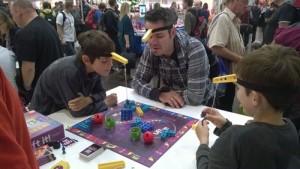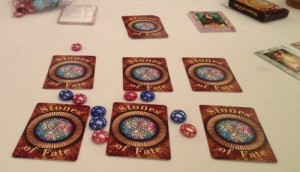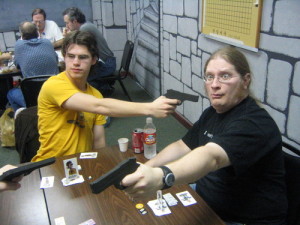Today I’m discussing something a little unusual. I thought it would be interesting to think about the basic actions humans can make and see how they’re used in games. Do games use all actions that people can take? Are there certain actions that stand on their own, preventing other types of actions? Are some actions just more fun than others?
I think my initial idea was a tad ambitious: listing every basic action a human can make is a little much for one blog post (or probably one lifetime, honestly). However, I still found the exercise to be both interesting and informative. I hope you agree!

Lift It! features non-basic physical manipulation. Image from Board Game Geek.
Physical Manipulation. From infancy, humans spend much of their time trying to manipulate the physical world with their hands (and their mouths, but few games explore that territory). While physical manipulation is much more heavily used by sports and twitchy digital games than tabletop games, almost every game uses physical manipulation to some degree. Some, such as Jenga, even make manipulating physical objects the focus of the game. (And games such as Lift It! involve physical manipulation in very unusual ways.) Some games, especially timed games such as Space Cadets: Dice Duel, feature dexterity and manipulation much more prominently than you might expect.
However, for most games, manipulation fades into the background, as players simply shuffle cards and move pieces. Manipulating the physical world with our hands is something so basic to the human experience that we don’t even notice it when it’s happening.
Reasoning
While I lumped all physical manipulation together above, the remaining basic actions I’ll divide into two parts: reasoning and social. I think there’s actually quite a bit of overlap, so these broad categories aren’t particularly accurate, but they are still useful for organizational purposes.
Pattern Match. Humans see patterns everywhere. It’s how people break down the world around them, and it’s how Go grandmasters maintain a (very flimsy) lead over computers. Pattern matching is used in almost all games, though like manipulation, it’s usually in the background. Some games, such as Set and Spot It!, place pattern matching at the center of the game experience, but most games want pattern matching to be automatic. If players realize they’re looking for patterns, they’re usually distracted from actual gameplay, so it’s the game and graphic designers’ jobs to make pattern matching as easy as possible. This is one of the main reasons colors are used so heavily in graphic design: people are particularly good at matching colors.
Compute. In our educational system, students spend years without science and history, but never without math. From our earliest days we’re taught to count our fingers, and those skills become ingrained to the point of feeling completely natural (to some people more than others). Almost all games use math to some degree, if only to count up a handful of points, but some games use it much more than that, like Power Grid and scoring in 7 Wonders.
While it might be controversial, I believe that game designers should try to shield players from math as much as possible. Designers tend to come from mathy backgrounds, so math doesn’t feel like a big deal. But to many people, even “easy” math, such as simple division or multi-step arithmetic, is a serious mental burden and opportunity for embarrassment. As the designer, make the game do as much of the math for the players as you can.
Compute Probabilities. I separate probabilities from other computation because humans are naturally awful at probabilistic thinking. Many game players are good at it (as a discipline, probability did start with games of chance, after all), but almost everyone else is extremely bad at it.
But almost any game with dice or cards involves probability. So how do so many games get away with randomness that players can reason about? The answer is that the players don’t need to understand probabilities to enjoy them. Just like with general computation, let your players think about probability if they want, but don’t force them to think about it to enjoy your game. Deck builders like Star Realms are a great example of this. You’re at an advantage if you can think about the probability of getting combos (and you really understand what those probabilities mean), but you can still enjoy the game by just playing cards and letting the deck worry about probabilities for you.

Few games require players to retain large amounts of information, but Stones of Fate makes memory a central activity. Image from Board Game Geek.
Remember. Our plastic brains are built to retain information, so you’d think our memories would be great. But a lot of psychological research has been dedicated to understanding how our memories work, and the verdict is that we’re more limited than you might expect. People can only retain a small amount of information at a time, a dozen pieces at most, and even keeping that much can be quite taxing. For that reason, games should usually keep track of as much information as possible so the player isn’t burdened by remembering details.
That said, remembering can be a central activity. Games such as Stones of Fate make remembering the main feature, hiding most information and rewarding players who can retain the glimpses they get. Unless your game emphasizes memory, though, it’s best to let your players worry about other things.
Plan. Unless a game is all tactics and no strategy, it involves some amount of anticipating what the future holds and preparing a place for yourself in it. While this gets a lot more complicated when other players are added to the mix, it’s the first basic action I would say is almost universally enjoyable. In many games, planning and adapting those plans as circumstances change are the central activities. Pandemic is a great example. Each turn, players look at the current state of the board, identify dangerous areas, and think about how best to use limited resources to address those challenges in the short and long term. Even though planning can be mentally taxing, it’s something your game should probably include.
Evaluate. In games, just as in life, the prices of items are often set, but prices don’t necessarily correlate to the value those items will provide. Determining what exactly something will provide, and whether it’s actually worth the time and resources to procure it, can be difficult. But it is a central feature of many games, especially games that involve auctions and fierce competition for limited resources like worker placement games. Evaluation is standard in games, even when not a central feature, to the point that players not only don’t mind it, they expect it.
Social Actions
Though there is a fair amount of overlap with reasoning, social actions involve other people. Social actions tend to be a step up in complexity, and for some people they can be very draining experiences. Still, perhaps more than anything else, social connections are what make tabletop games stand out from digital games, and many players crave this aspect of the hobby.
Communicate. The most basic way players can interact is by sharing information. Some co-op and team games feature communication centrally–Hannabi, for example, makes sharing information a limited basic action, and party games like Cranium challenge players to communicate in unusual ways. But more often, communication takes a side role to other central activities.

Ca$h & Gun$ spices up pointing as a central activity. Image from Board Game Geek.
Point. One special form of communication I want to highlight is pointing. It is one of the most basic forms of communication for humans, something that children do from a very young age, and it is used more than you might think in games. Pointing (and other forms of simple non-verbal communication, like revealing a card or a number of tokens) is much easier to execute and process than players freely talking. It turns a free form task into a multiple choice one. And some games, like Ca$h & Gun$, turn a simple action into a major highlight of the whole experience. Whenever your players need to communicate information, ask yourself if your game would be better if that communication was more streamlined and simplified. It even lets groups that speak different languages enjoy your game!
Conceal. While few competitive games feature intentional communication as a central action, many encourage players to conceal information from one another. This takes many forms, from hiding information, to misleading, to outright lying. In any case, information is an asset to players, and you have an advantage when you know more than other players. Poker is the poster child for games that focus on hiding information, but even games with perfect information, like Small World, reward players for keeping their plans a secret.
And of course, with concealing, comes its opposite, detecting deception. Whenever one player tries to hide information, the other players are going to try to figure that information out. This back and forth is the central feature of many games, from secret identity games like The Resistance to hidden information games like Stratego. These activities make a satisfying main activity for a game, but they can also work well as a small part to spice things up for more advanced players.
Negotiate. Negotiation occurs whenever multiple people have to agree on something. Usually, no one can get exactly what he or she wants out of the deal. Negotiation often involves communication about matters that are subjective. It frequently involves deception as players try to convince each other of the relative values of different items. It can also involve threats, intimidation, and other aggressive social behavior.
Perhaps the ultimate form of negotiation is in bartering. In games like Settlers of Catan, players trade different resources with each other, but those resources vary in value over time and for different players. Here, players try to give as little as possible for the resources they need, which can involve a lot of back and forth.
When a game features negotiation, it is almost always the central activity of the game. If other activities are included, they are often in service of the negotiation. That’s because negotiation is a very demanding activity. Not only does it take a lot of mental energy, it takes up a lot of time.
Conclusion
I know this isn’t a complete list… I have more than one friend that would give me quite the scolding to see that “pun” is not among the above basic activities. I didn’t cover many activities, like imagining and wordplay, because I don’t have the time or expertise to do so. But I encourage others to add to the list in the comments.
Even knowing this list is imperfect, I found the exercise of explicitly writing it very informative. Since I started designing games, my attention has moved further from the components and mechanics of the game and more towards the experience of the players, and this list marks a new extreme for that perspective. It’s not that the components and mechanics aren’t important–it’s that they are means to help create the perfect experiences.
How can this list help you practically? I recommend looking at the game you’re designing and ask yourself, what’s the central activity of this game? What are the other activities in it? Do they distract from the central activity? Could they be reduced or toned down so the central activity is more the focus? You never know when turning open ended communication into streamlined pointing might make the deception that much more fun.

4 Comments